程式設計師你是如何使用Nacos作為配置中心的?
阿新 • • 發佈:2020-10-10

> 假如你使用的是spring-cloud-alibaba微服務技術棧
# 單個服務獨有配置檔案
即去除應用程式的狀態,配置統一外部化管理,方便進行水平的伸縮。
整合步驟:
假如我有一個應用app-design;
1,引入依賴:
```xml
com.alibaba.cloud
spring-cloud-starter-alibaba-nacos-config
2.2.1.RELEASE
```
2, 配置檔案;
```
spring.cloud.nacos.config.enabled=true
spring.cloud.nacos.config.refresh-enabled=true
spring.cloud.nacos.config.server-addr=${spring.cloud.nacos.discovery.server-addr}
spring.cloud.nacos.config.namespace=${spring.cloud.nacos.discovery.namespace}
```
說明如下:
| 屬性 | 說明 |
| --- | --- |
| spring.cloud.nacos.config.server-addr=${spring.cloud.nacos.discovery.server-addr} | nacos配置中心地址 |
| spring.cloud.nacos.config.namespace=${spring.cloud.nacos.discovery.namespace} | nacos的名稱空間,這裡跟服務發現的配置一致; |
3,使用配置的方式,同本地配置檔案一樣。
@Value @PropertyConfiguration 這些註解都是支援的;
4,確認方式,比如把之前的application.properties的配置放到了配置中心;
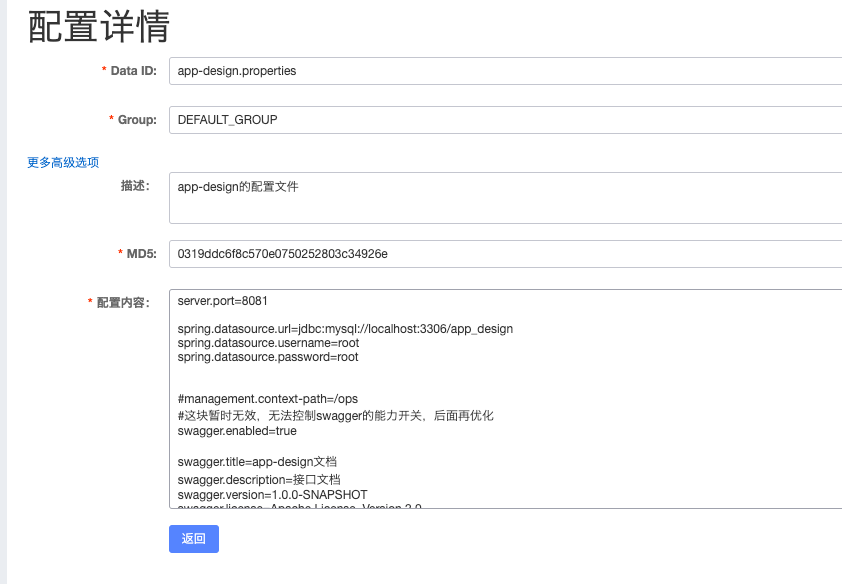
本地啟動的時候,讀取到了8081埠和資料庫連線池的配置;

配置中心的連線原理,後面單獨整理出來,知其然並知其所以然。
# 服務之間共享配置檔案
場景:多個後端微服務,在同一個叢集中共用中介軟體的配置資訊。
比如 快取redis, 訊息佇列kafka, 檔案伺服器, 郵件伺服器;
那麼對應的配置檔案沒有必要在所有的後端微服務中單獨存在,這些配置檔案應該放在公共配置檔案中,但是也可以被具體的後端微服務自己的獨有配置檔案覆蓋,使用自己的私有配置;
可結合下圖理解:

| 問題 | 回答 |
| --- | --- |
| where are we?現狀 | 中介軟體配置分散在很多服務中,配置繁瑣,不方便統一管理 |
| where are we go?目的 | 同一個叢集的中介軟體只維護一份,各服務共享,也可按照需要覆蓋共享的配置; |
| how can we go there?實現路徑 | 基於nacos已有功能實現 |
下面是實際的coding過程和測試用例;
服務app-file;
在服務對應的nacos的namespace中
## 1 引入共享配置
```
#共享中介軟體的配置
spring.cloud.nacos.config.shared-configs[0].data-id=mid.properties
spring.cloud.nacos.config.shared-configs[0].group=DEFAULT_GROUP
spring.cloud.nacos.config.shared-configs[0].refresh=true
```
位置: 模組start下的src/main/resources/bootstrap.properties檔案中
自描述的配置資訊,即引入的共享配置檔案列表有哪些,可以按照需要,配置各種中介軟體的配置資訊;
| key | 說明 |
| --- | --- |
| data-id | _the data id of extended configuration 配置檔名稱,帶上字尾;翻譯:擴充套件配置檔案的資料id |
| group | _the group of extended configuration, the default value is DEFAULT_GROUP 叢集名稱, 從名字來看,支援多叢集的配置檔案 翻譯:擴充套件配置檔案的叢集,預設值是 _DEFAULT_GROUP_ |
| refresh | _whether to support dynamic refresh, the default does not support 是否重新整理 翻譯:是否支援動態重新整理,預設不支援 |
花括號[0] ,裡面的0是序號,如果有多個,按照數字自增順序進行配置;
## 2 在nacos中新增配置檔案
根據實際場景在nacos的test名稱空間中新增配置檔案mid.properties
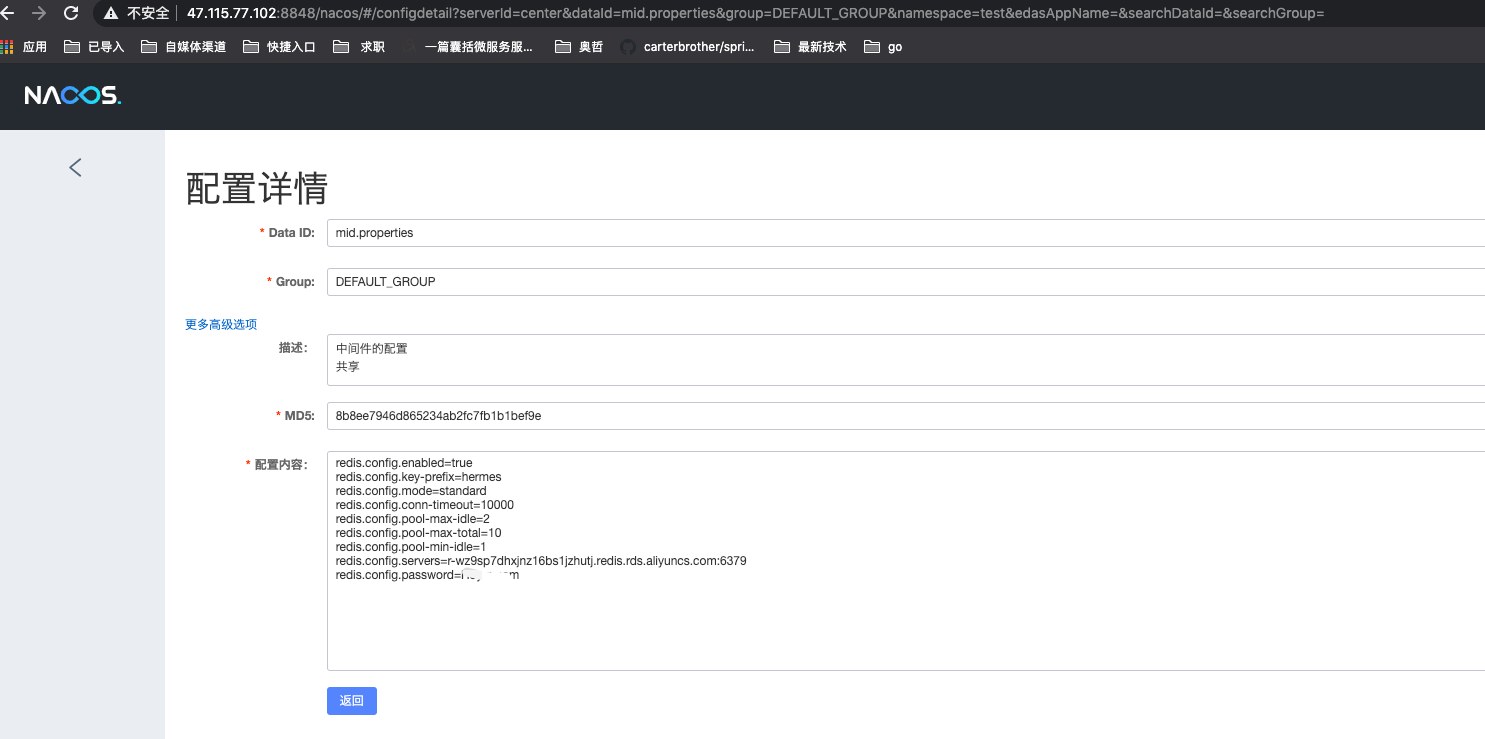
## 3 獲取配置用例測試
測試介面程式碼:
```java
@ApiOperation("測試獲取公共配置檔案")
@GetMapping("/config/test")
public Response config(){
String redisConfigServers = environment.getProperty("redis.config.servers","null");
return SingleResponse.of(redisConfigServers);
}
```
測試用例:
| 場景 | 期望結果 | 實際結果 | 是否符合預期 |
| --- | --- | --- | --- |
| 獲取共享配置檔案中的配置 | r-wz9sp7dhxjnz16bs1jzhutj.redis.rds.aliyuncs.com:6379 | r-wz9sp7dhxjnz16bs1jzhutj.redis.rds.aliyuncs.com:6379 | 是 |
| 在服務獨有app-file.properties配置中重寫配置redis.config.servers=r-wz9sp7dhxjnz16bs1jzhutj.redis.rds.aliyuncs.com:637905 | r-wz9sp7dhxjnz16bs1jzhutj.redis.rds.aliyuncs.com:637905 | r-wz9sp7dhxjnz16bs1jzhutj.redis.rds.aliyuncs.com:637905 | 是 |
截圖如下:
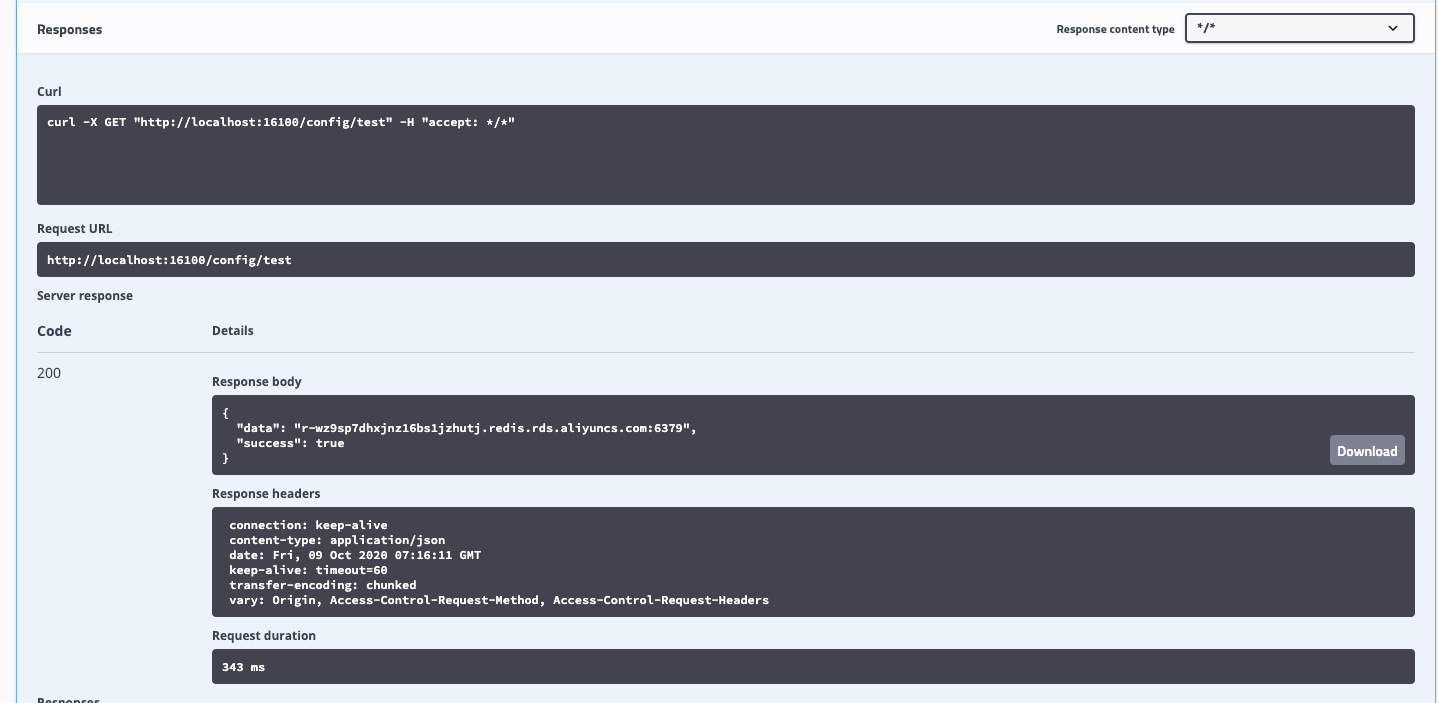
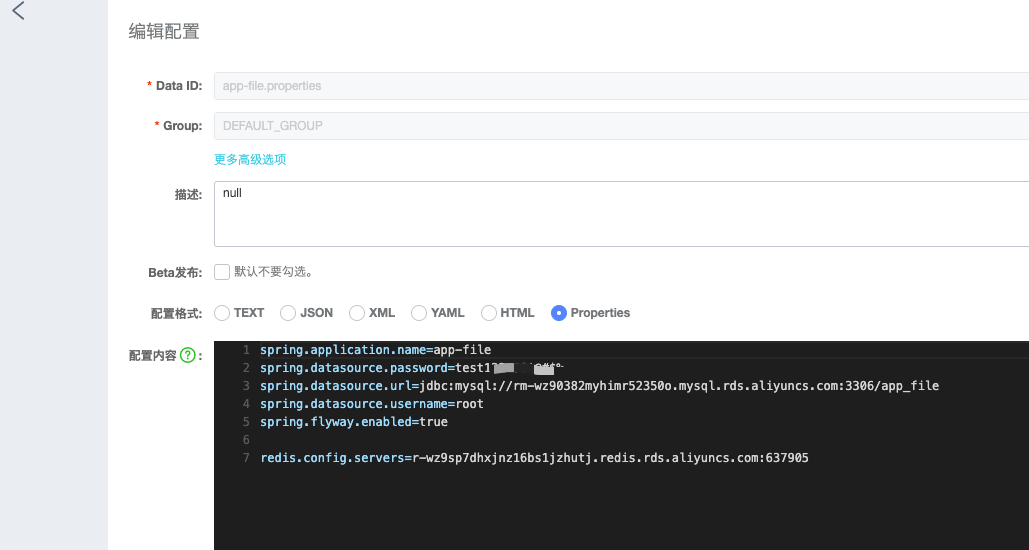
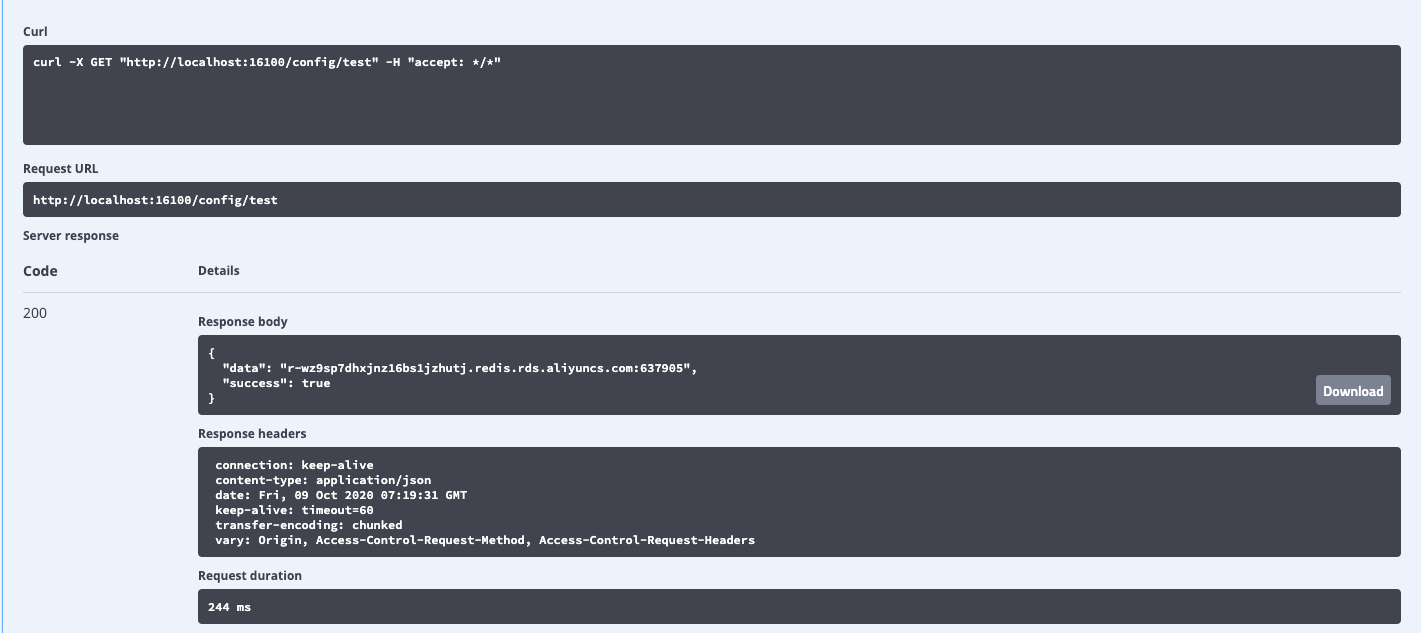
# 原始碼分析
掌握用法之後,深入分析原始碼,知其然而知其所以然;
## starter呼叫封裝
使用的starter封裝;
[https://github.com/alibaba/spring-cloud-alibaba/spring-cloud-alibaba-starters/spring-cloud-starter-alibaba-nacos-config](https://github.com/alibaba/spring-cloud-alibaba/spring-cloud-alibaba-starters/spring-cloud-starter-alibaba-nacos-config)
版本: 2.2.1.RELEASE
啟動的時候自動裝配的配置如下:
```java
org.springframework.cloud.bootstrap.BootstrapConfiguration=\
com.alibaba.cloud.nacos.NacosConfigBootstrapConfiguration
org.springframework.boot.autoconfigure.EnableAutoConfiguration=\
com.alibaba.cloud.nacos.NacosConfigAutoConfiguration,\
com.alibaba.cloud.nacos.endpoint.NacosConfigEndpointAutoConfiguration
org.springframework.boot.diagnostics.FailureAnalyzer=\
com.alibaba.cloud.nacos.diagnostics.analyzer.NacosConnectionFailureAnalyzer
```
分解一下key,看一下用途:
| key | 說明 |
| --- | --- |
| org.springframework.cloud.bootstrap.BootstrapConfiguration | _A marker interface used as a key in invoke() {
Map result = new HashMap<>(16);
result.put("NacosConfigProperties", properties);
List all = NacosPropertySourceRepository.getAll();
List> sources = new ArrayList<>();
for (NacosPropertySource ps : all) {
Map source = new HashMap<>(16);
source.put("dataId", ps.getDataId());
source.put("lastSynced", dateFormat.get().format(ps.getTimestamp()));
sources.add(source);
}
result.put("Sources", sources);
result.put("RefreshHistory", refreshHistory.getRecords());
return result;
}
```
NacosConfigHealthIndicator
健康檢查 UP,DOWN,UNKNOWN ;
### 3 NacosConnectionFailureAnalyzer
連線不上nacos服務端丟擲異常
```java
@Override
protected FailureAnalysis analyze(Throwable rootFailure,
NacosConnectionFailureException cause) {
return new FailureAnalysis(
"Application failed to connect to Nacos server: \""
+ cause.getServerAddr() + "\"",
"Please check your Nacos server config", cause);
}
```
小結:服務通過整合該starter,通過http請求從nacos的服務端拉取配置資料,並做了 配置刷新歷史,註冊監聽器到spring容器中, 本地快取,和錯誤報告;
## 服務端封裝
原始碼位置:[https://github.com/alibaba/nacos/tree/develop/config](https://github.com/alibaba/nacos/tree/develop/config)
應用啟動讀取配置檔案整體呼叫鏈:待後續完成;
# 小結
>如果讀完本篇文章你只能記住一句話:nacos作為配置中心可為單獨的服務提供外部化配置檔案,也支援多應用共享配置檔案。
>從nacos的客戶端原始碼分析中可看到一些配置優先順序的順序。
> 原創不易,關注誠可貴,轉發價更高!轉載請註明出處,讓我們互通有無,共同進步,歡迎溝通
META-INF/spring.factories